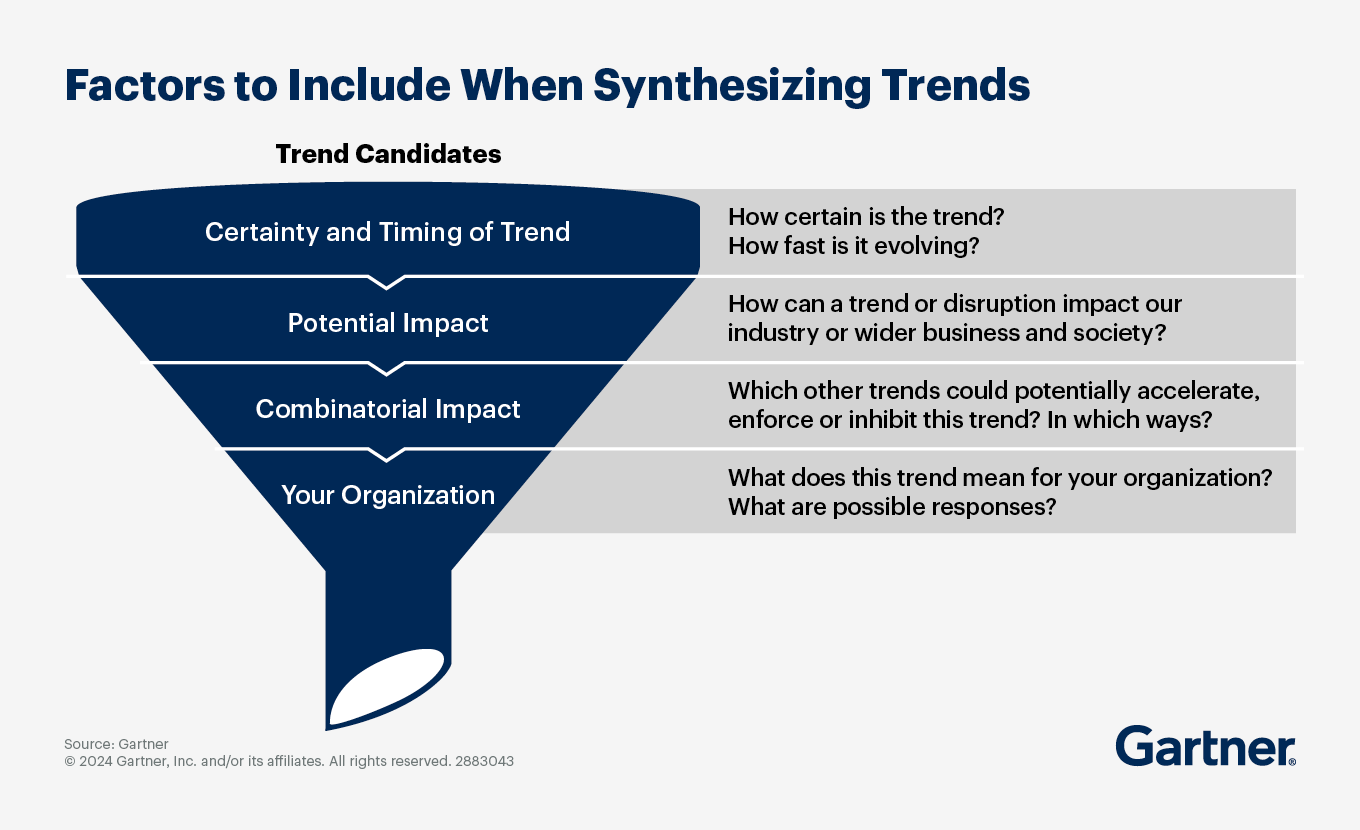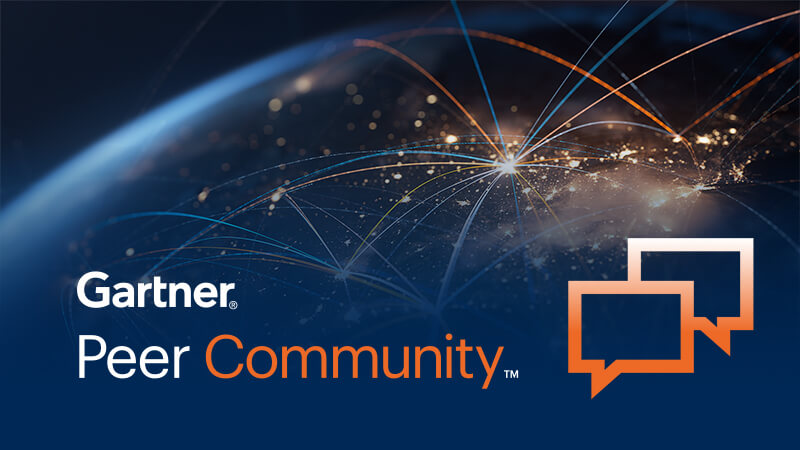Understanding disruptive trends and technologies is critical for CIOs to innovate the future of IT and digital value creation.
- Gartner client? Log in for personalized search results.
Future of IT Depends on CIOs Scoping Disruptive Trends
CIOs must lead the future of IT to adapt to disruption and capture opportunities
CIOs can lead the discovery of disruptive trends and technologies to surface the opportunities and threats they present — and prioritise the future of IT to incorporate strategic and operational responses that will drive enterprise value.
Use this research to:
Organise a trendspotting capability to turn foresighting from an ad hoc to an intentional capability
Use continuous foresight to anticipate trends and prepare your enterprise’s responses
Nurture futurist thinking
Innovative CIOs proactively scope for disruptive trends
CIOs must install capabilities to recognise disruptive trends early, and articulate potential threats and opportunities across a range of scenarios so the enterprise can prepare. Two actions are key.
- Turn on Trendspotting
- Anticipate Emerging Trends
- Uncover Future Trends
Using deliberate trendspotting capabilities mitigates blind spots
Most organisations spot trends ad hoc, but a deliberate trendspotting capability mitigates blind spots and biases that arise from ad hoc approaches. Deliberate trendspotting filters signals from noise, so leaders can focus on the key trends.
CIOs can partner with other executives to gather diverse insights across these categories. To set up a comprehensive trendspotting capability, CIOs should address:
Objectives and goals: Establish the business drivers behind a trendspotting effort — for example, strategic risk mitigation or desire to exploit new market opportunities.
Scope: Define what the trendspotting approach will do. Identify the types of trends to be explored.
Team: Set up the team that will drive the trendspotting approach. Often, this will include part-time ‘trend scouts’ across the organisation who will be responsible for monitoring trends within their respective domains. Including external stakeholders, such as customers, suppliers and academic staff as virtual team members, can add valuable perspectives and reduce bias.
Governance: Agree to whom the group will report, who is responsible for tracking various trend categories and how the trend work will be communicated to other business groups.
Resources: Empower the team with the right resources, including access to trend sources and the necessary funding to deliver the defined scope.
Metrics and reporting: Explain how the success of the continuous trendspotting approach will be measured. Identify the business impact metrics for how it will influence strategy, operations and innovation.
CIOs can use a framework like the Gartner ‘Tapestry of Trends’ to scope for a diverse set of trends, including those that may lie beyond their everyday IT responsibilities.
In each trend area, start by asking ‘What if …?’ to help you determine what possibilities could become your mission-critical priorities. The figure shows the range of trends you need to chart.
Continuous foresight helps CIOs anticipate trends and prepare the organisation
Organisations cannot afford to treat disruptions as one-off exceptions. Innovative CIOs establish formal processes to continuously plan for and respond to future disruptions.
Future-oriented models like the Gartner Continuous Foresight approach provide CIOs with a framework to identify and respond to disruptions and trends.
It can be used:
Defensively to blunt the impact of a disruption
Offensively to take advantage of disruptions by identifying new business opportunities and turning them into new solutions
The Continuous Foresight Framework comprises four key actions:
Acquire insights about diverse trends and potential disruptions. Start with a broad scan of the business environment to identify current and future trends that have potential enterprise impact. Sources can be internal (such as executives, internal research or marketing functions, and subject matter experts) and external (market research, consultants, media, academia and industry consortia) but should include opposing viewpoints and the occasional wildcard.
Synthesise and contextualise the insights for your enterprise, industry and market to understand the opportunities and threats. This includes testing your current strategies and plans against emerging trends. The aim is to filter multiple trends and disruptions down to a smaller set that will likely have the largest impact on the organisation.
Advocate the likely impacts to your organisation and collaborate to identify responses. This includes creating communications tools, such as trend cards, radars and other visualisations.
Prepare your enterprise response by evolving strategy, operating model, innovation initiatives or operational plans. This stage turns insights and possible responses into actions and decisions about where and when to exploit trends and take action. In this phase, involve a wide array of leaders outside IT and link the trendspotting work to current business operations, as well as current and future business strategies.
Join us at Gartner IT Symposium/Xpo™ to learn more about the trends shaping our future.
Navigating through current disruptions and social and economic trends can be challenging. However, it is crucial for CIOs to look ahead and lead their organisations towards long-term success.
Join your peers at Gartner IT Symposium/Xpo™ 2024 to gain insights from experts on the disruptive trends to watch out for and how to prepare for an uncertain future.
Gartner IT Symposium/Xpo is the premier event for CIOs to gather and discuss the future of technology and business. This year’s agenda features sessions that bring the latest research to life, including:
- Signature Series: Top Strategic Technology Trends for 2025
- The 7 Forces Impacting Your Organisation’s Future: Tapestry 2025
- Hype Cycle for Emerging Technologies
- 7 Disruptions You Might Not See Coming: 2024-2029
Discover more insights on disruptive trends at Gartner IT Symposium/Xpo:
Shaping a Better Digital Future
Find out how Gartner helped Deakin University improve digital services, increase the value received by staff and students, and create a new operating model with key innovative digital investments.
Now on Gartner Peer Community™:
How can you avoid the hype of emerging technologies?
Join timely peer discussions around this topic and others on Gartner Peer Community™. Powered by 100,000+ members, this exclusive network of leaders and executives provides peer connections, conversations and actionable advice.
Related future of IT value resources
Gartner clients: Log in for a complete suite of actionable insights and tools on future of IT.
Drive stronger performance on your mission-critical priorities.





